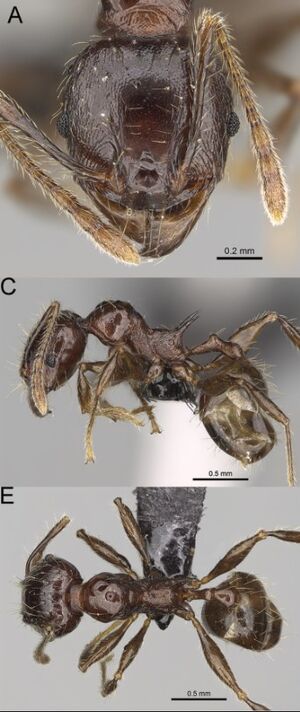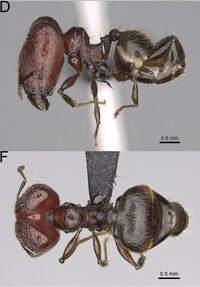Pheidole aelloea
| Pheidole aelloea | |
|---|---|

| |
| Scientific classification | |
| Kingdom: | Animalia |
| Phylum: | Arthropoda |
| Class: | Insecta |
| Order: | Hymenoptera |
| Family: | Formicidae |
| Subfamily: | Myrmicinae |
| Tribe: | Attini |
| Genus: | Pheidole |
| Species group: | ensifera |
| Species: | P. aelloea |
| Binomial name | |
| Pheidole aelloea Salata & Fisher, 2020 | |
The species was collected between 10–2100 m in elevation, in rainforest, tropical dry forest, littoral rainforest, montane rainforest, and montane shrubland. Nests were located in rotten logs, rotten sticks on ground, dead twigs above ground, and soil.
Identification
Salata and Fisher (2020) - A member of the Pheidole ensifera species group. Major. Body size moderate: HL: 1.85-2.45 (2.0), HW: 1.56-2.02 (1.64), WL: 1.17-1.35 (1.25); propodeal spines very long (PSL: 0.38-0.48 (0.42)); head in full-face view rectangular, with lateral sides relatively straight, only their posteriormost part slightly convex; sides of the head with sparse, relatively long, erect pilosity; occipital lobes shiny, with sparse and thick rugoreticulation; inner hypostomal teeth distinct, triangular, and moderately thin, with rounded apex, closely spaced; outer hypostomal teeth distinct, approximately as high as inner hypostomal teeth, lobe-like, with base wider than inner hypostomal teeth, inner and outer teeth closely spaced and connected by indistinct concavity. Minor:. Body size moderate: HL: 0.63-0.78 (0.68), HW: 0.61-0.79 (0.67), WL: 0.83-0.98 (0.9); propodeal spines very long (PSL: 0.3-0.37 (0.32)); scape, when laid back, surpassing posterior head margin by one-fifth of its length; lateral sides of head and malar area finely rugulose, sculpture weakening posteriorly; vertex, genae, and frons smooth; pronotum, dorsal surface of mesonotum, and dorsal and posterior surface of propodeum smooth, sometimes propodeum with indistinct, sparse rugulae; katepisternum, anepisternum, and lateral sides of propodeum with thick and dense rugo-punctae.
This species is most similar to Pheidole ocypodea and Pheidole podargea. Major workers. Pheidole aelloea can be distinguished from P. ocypodea by slightly convex posterior declivity of promesonotum and inner and outer hypostomal teeth not pointed inward or outward; it differs from P. podargea by longer and sparser pilosity on sides of head and reduced to absent sculpture on genae and propodeum. Minor workers. Pheidole aelloea can be distinguished from P. ocypodea by finely rugulose and never smooth lateral sides of head and malar area, absence of metanotal groove, long petiolar peduncle, and short postpetiole which is approximately as long as high; it differs from P. podargea in smooth sculpture of vertex, genae, and area between frontal carinae, absence of promesonotal and metanotal groove, and at least partially smooth surface of pronotum, dorsal surface of mesonotum, and dorsal and posterior surface of propodeum.
Keys including this Species
Distribution
Distribution based on Regional Taxon Lists
Malagasy Region: Madagascar (type locality).
Distribution based on AntMaps
Distribution based on AntWeb specimens
Check data from AntWeb
Countries Occupied
| Number of countries occupied by this species based on AntWiki Regional Taxon Lists. In general, fewer countries occupied indicates a narrower range, while more countries indicates a more widespread species. |

|
Biology
Castes
Worker
Minor

| |
| . | |
Images from AntWeb

| |
| Worker. Specimen code casent0923221. Photographer Michele Esposito, uploaded by California Academy of Sciences. | Owned by CAS, San Francisco, CA, USA. |
Major
Images from AntWeb

| |
| Holotype of Pheidole aelloea. Worker (major/soldier). Specimen code casent0236213. Photographer Michele Esposito, uploaded by California Academy of Sciences. | Owned by CAS, San Francisco, CA, USA. |
Nomenclature
The following information is derived from Barry Bolton's Online Catalogue of the Ants of the World.
- aelloea. Pheidole aelloea Salata & Fisher, 2020: 77, figs. 31A–F, 84A, 86A (w.q.) MADAGASCAR.
Unless otherwise noted the text for the remainder of this section is reported from the publication that includes the original description.
Description
Worker
Major (N = 10): HL: 1.85-2.45 (2.0); HW: 1.56-2.02 (1.64); SL: 0.73-0.89 (0.77); EL: 0.14-0.18 (0.16); WL: 1.17-1.35 (1.25); PSL: 0.38-0.48 (0.42); MTL: 0.67-0.89 (0.75); PNW: 0.7-0.8 (0.73); PTW: 0.2-0.22 (0.2); PPW: 0.59-0.7 (0.66); CI: 79.6-85.9 (83.2); SI: 44.1-49.3 (46.9); PSLI: 19.8-25.0 (21.5); PPI: 28.3-34.5 (31.0); PNI: 39.5-46.8 (44.8); MTI: 41.8-50.6 (45.8). Head. In full-face view rectangular, lateral sides relatively straight, only their posteriormost part slightly convex. In lateral view oval; ventral and dorsal faces finely convex; inner hypostomal teeth visible. Sides of the head with sparse, relatively long, erect pilosity; whole head with sparse, relatively long, erect pilosity. Antennal scrobes indistinct and not delimited by carinulae. Occipital lobes shiny, with sparse and thick rugoreticulation; genae shiny, with fine and sparse rugoreticulation, sometimes posterior part with reduced sculpture; malar area and frons with longitudinal and sparse rugae, on posterior part of frons rugae directed outward and more irregular, interspaces smooth; lateral sides of head shiny, with irregular, moderately dense and thick rugoreticulation. Centre of clypeus smooth and shiny, lateral sides with longitudinal rugae; median notch present, moderately wide, and narrow; median longitudinal carina present; lateral longitudinal carinae absent. Scape, when laid back, reaching mid-length of head; pilosity suberect to erect. Inner hypostomal teeth distinct, triangular, and moderately thin, with rounded apex, closely spaced; outer hypostomal teeth distinct, approximately as high as inner hypostomal teeth, lobe-like, with base wider than inner hypostomal teeth, inner and outer teeth closely spaced and connected by indistinct concavity. Mesosoma. In lateral view, promesonotum short, angular, and high, with slightly convex posterior declivity; promesonotal groove absent; metanotal groove absent; propodeal spines very long, narrow, massive basally, with acute apex; humeral area laterally absent to weakly produced. Surface shiny, pronotum, dorsal surface of mesonotum, and dorsal and posterior surface of propodeum with fine, sparse to moderately sparse rugoreticulation, sometimes sculpture on propodeum strongly reduced and absent on its dorsal surface; katepisternum, anepisternum, and lateral sides of propodeum with thick and sparse rugoreticulation. Pilosity moderately sparse, long, and erect. Petiole. Shagreened; peduncle relatively long, with triangular apex, and thick horizontal lobes on its basal part; node triangular with rounded apex, in rear view node dorsoventrally slightly depressed; pilosity moderately sparse and erect. Postpetiole. Shagreened; in dorsal view sides with acute, moderately long, relatively narrow, and angular projections; pilosity long, moderately sparse, and erect. Petiole. First gastral tergite shagreened, at least on its basal part; pilosity moderately sparse, long, and erect. Colour. Unicolourous, ocherous to reddish-brown, sometimes head brighter than the rest of the body.
Unless otherwise noted above, the following characters occur in this species, and the majority of Pheidole majors of Madagascar described by Salata and Fisher 2020a. Antennal sockets shallow; frontal lobes absent; head in full-face view with distinct median concavity; antenna 12-segmented, with 3-segmented club; masticatory margin of mandible with large, stout apical and preapical teeth, followed by a long diastema and then a short and crenulate tooth just before the rounded basal angle; outer surface of mandible mostly smooth and shining, sometimes with weak and sparse foveolae; antennal scrobes present; promesonotum strongly convex, well above the level of propodeum; postpetiole short with slightly convex dorsum; ventral process absent.
Minor (N = 10): HL: 0.63-0.78 (0.68); HW: 0.61-0.79 (0.67); SL: 0.66-0.8 (0.7); EL: 0.09-0.13 (0.11); WL: 0.83-0.98 (0.9); PSL: 0.3-0.37 (0.32); MTL: 0.52-0.66 (0.57); PNW: 0.39-0.49 (0.42); PTW: 0.09-0.14 (0.1); PPW: 0.15-0.25 (0.19); CI: 95.9-102.7 (98.3); SI: 100.5-119.0 (105.9); PSLI: 43.0-49.5 (46.7); PPI: 48.5-64.9 (54.3); PNI: 60.3-65.6 (63.0); MTI: 83.3-88.1 (85.5). Head. In full-face view square, posterior of eyes slightly convex, anterior of eyes relatively straight, occipital margin straight or indistinctly convex; occipital carina indistinct, weakly developed. Pilosity sparse, long, and erect. Lateral sides of head and malar area finely rugulose, sculpture weakening posteriorly; vertex, genae, and frons smooth; antennal sockets with sparse carinae curved outward. Clypeus with median longitudinal carina present; two lateral longitudinal carinae present. Scape, when laid back, surpassing posterior head margin by one-fifth of its length; pilosity suberect to erect. Mesosoma. In lateral view, promesonotum high, short, and convex; promesonotal groove absent; metanotal groove absent; propodeal spines very long, massive basally, with acute apex. Surface shiny, pronotum, dorsal surface of mesonotum, and dorsal and posterior surface of propodeum smooth, sometimes propodeum with indistinct, sparse rugulae; katepisternum, anepisternum, and lateral sides of propodeum with thick and dense rugose punctae. Pilosity sparse, long, and erect. Petiole. Vertex of peduncle finely shagreened; peduncle long and moderately thin; node low, bulge-like; with few long, erect setae. Postpetiole. Moderately long, low, and slightly convex; with few long, erect setae at the anterior edge. Petiole. With few long, erect setae. Colour. Unicolourous, brown to dark brown.
Unless otherwise noted above, the following characters occur in this species, and the majority of Pheidole minors of Madagascar described by Salata and Fisher 2020a. Antennal sockets shallow; frontal lobes absent; head in full-face view oval, posterior and anterior of eyes convex; antenna 12-segmented, with 3-segmented club; humeral area not developed; clypeus smooth and shiny; its anterior margin regularly convex; promesonotum well above the level of propodeum; petiole smooth; petiole with node moderately low, triangular and small postpetiole smooth; gaster smooth and shiny.
Type Material
Holotype. Madagascar. 1 major worker; Antsiranana; Makirovana Forest; -14.17066, 49.95409; alt. 415 m; 29 Apr 2011; B.L. Fisher et al. leg.; BLF26671, CASENT0236213 (California Academy of Sciences). Paratypes. Madagascar. 2w., 1q.; same data as for holotype; CASENT0923221, CASENT0236212, CASENT0872221 (CASC).
Etymology
Named after Aello, a harpy from Greek mythology, in reference to the long, sharp propodeal spines of minor workers reminiscent of claws.
